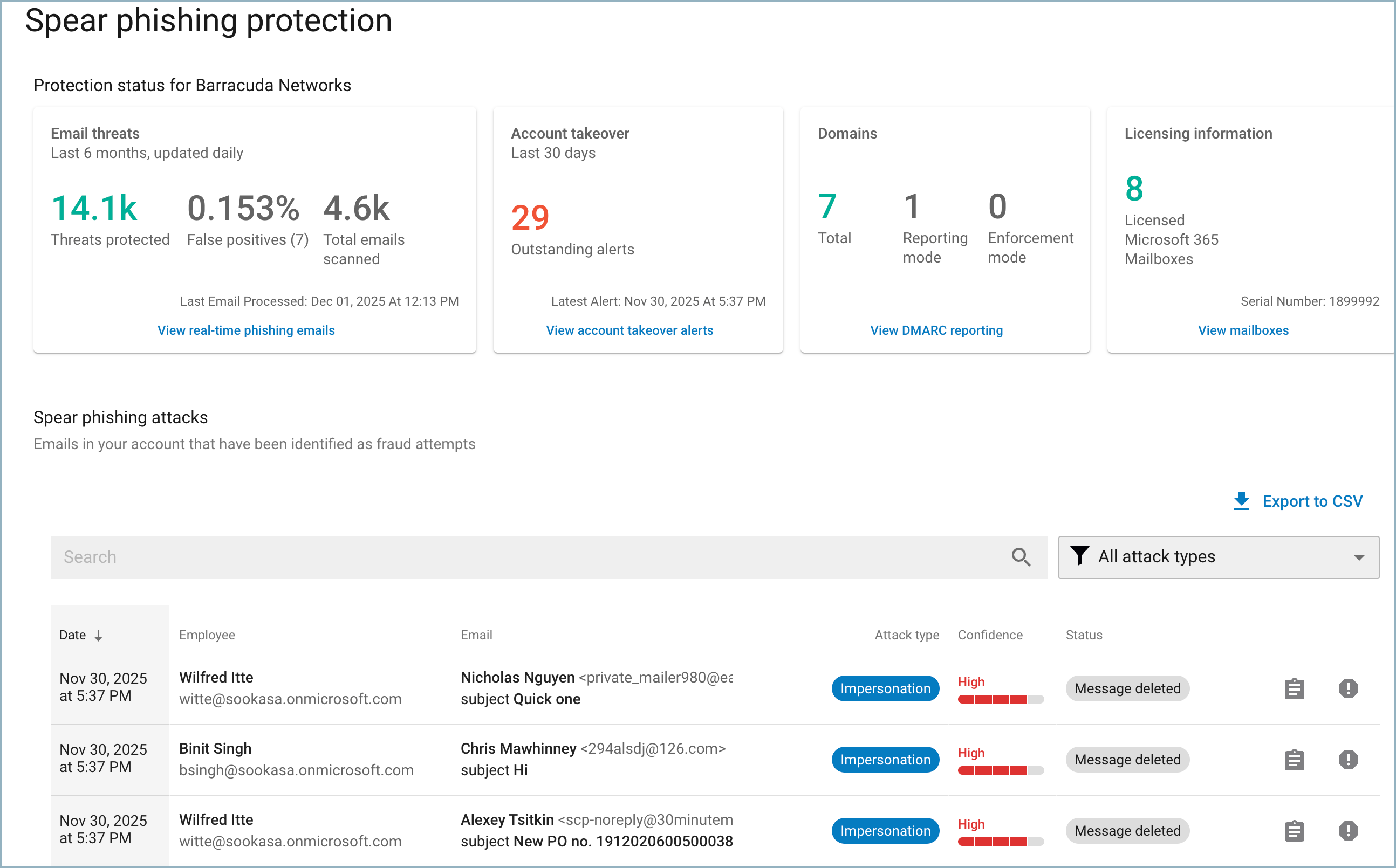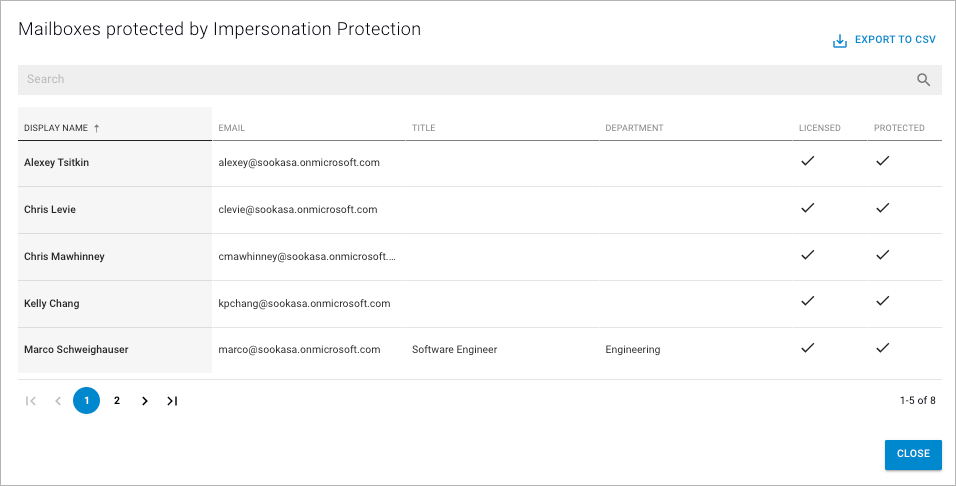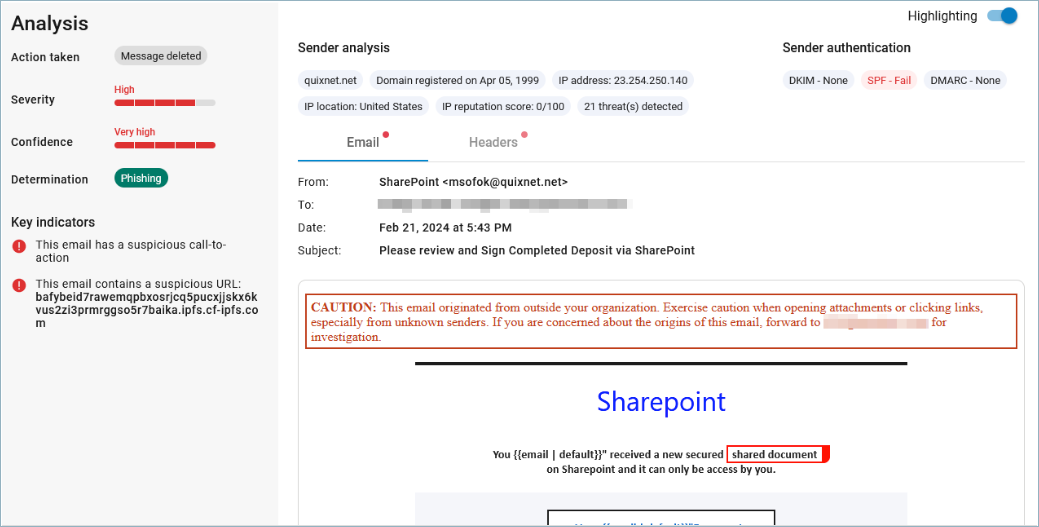When you first log into Impersonation Protection, the Spear Phishing Protection page appears. You can also reach the Spear Phishing Protection page at any time from the menu in the upper left corner of any Impersonation Protection page.

Viewing Licensed and Protected Mailboxes
In the Licensing Information box, click View Mailboxes. On the Impersonation Protection for your mailboxes page, each mailbox – for users and shared – is displayed, along with Display Names.

Each mailbox can have either one or both status values:
Licensed – Whether that mailbox has a Microsoft Exchange license.
Protected – Whether the mailbox is currently monitored and protected by Barracuda.
Exporting Mailbox Information
You can export and download this mailbox information to a CSV file, so you can use it for other administrative functions.
To export your mailbox information:
On the Spear Phishing Protection page, in the Licensing Information box, click View Mailboxes.
On the Impersonation Protection for your mailboxes page, click Export to CSV.
The CSV file downloads automatically to your usual download location.
Note for larger organizations: The first 20,000 of your mailboxes are exported, based on the Display Name value. Your searching or changing the sort order does not affect the export.
Viewing Recent Spear Phishing Attacks
The Spear Phishing Protection page displays recent spear phishing attacks.
Each attack shows the Attack Type and Confidence Score, described below.
Exporting Spear Phishing Information
Click Export to CSV to export records that are displayed in the pages of the table, up to a limit of 10,000 records, sorted by date.
Locating Specific Attacks
To locate specific attacks:
Search – Enter all or part of a word in the Search box to find matching incidents.
Filter Attacks – Click to display a list where you can choose to see all attacks or one of the Attack Types described here:
All Attack Types – No filter
Conversation Hijacking – A nefarious actor uses compromised credentials to insert themselves into a legitimate email thread, using a slightly altered domain, and attempt to take over lucrative opportunities, like bank transfers. Domain Hijacking, using a slightly altered Sender domain, as just described, can be a part of a Conversation Hijacking attack.
Extortion – A nefarious actor is demanding money from your organization, threatening that if they do not receive the funds, they will publish information that will be embarrassing to your organization or to people within it.
Impersonation – A nefarious actor is sending email, pretending to a member of your organization or pretending to represent a service, like a bank or an internet service provider.
Scamming – A nefarious actor is trying to get money from you or your organization.
For any record, click the details icon ![]() to see more information about it.
to see more information about it.
Message Details
The Message details page shows additional information for a specific attack.
Sender Information
The top of the message detail provides information pertaining to the sender as well as the results of the sender authentication checks performed by the email gateway.
Note: Impersonation protection does not do any of its own sender authentication checks and simply users the information found in the Authentication-Results header.

For customers using Email Gateway Defense, the sender authentication results header injected by EGD will be used. For all other customers, the Microsoft sender authentication results will be used.
If any failures are noted in the results header, the corresponding header will be highlighted.
Here is an example of the Barracuda results header:
Email and Headers Tabs
Select each tab to review
The contents of the email
Full header information from the email
Name, size, and type of attachments, if any
Analysis
The Analysis panel provides Barracuda Networks' findings on the attack.
Severity – The seriousness of this threat, based on its attack type. For example, an impersonation attack will always have a higher severity score than scamming.
Confidence – A measure of the likelihood that this email is an actual threat, based on internal classifiers and calculations.
Determination – The type of attack, based on Key Indicators below. Attack types are listed above in the Locating Specific Attacks section.
Key Indicators – Characteristics typical of an attack type of the attack that led to its attack type determination.
Highlighting
Toggle to enable Highlighting at top-right to see the elements of a message that Barracuda Impersonation Protection deem as suspicious. Keywords and phrases in the message content will have red boxes around them. These keyword and phrases are those that are typically seen in fraudulent emails. Other identifiers, shown via the Sender Information chips and Header information will display in red. The Email and Header tabs will show red dots if they display suspicious information.
Report False Positive
Click Report False Positive if you think this email is not an actual attack. For details, refer to False Positives.
Find Similar Messages
When viewing the details of an attack, you can click Find Similar Messages to open the Incident Response feature, where you can locate incidents similar to the one you are currently viewing.
